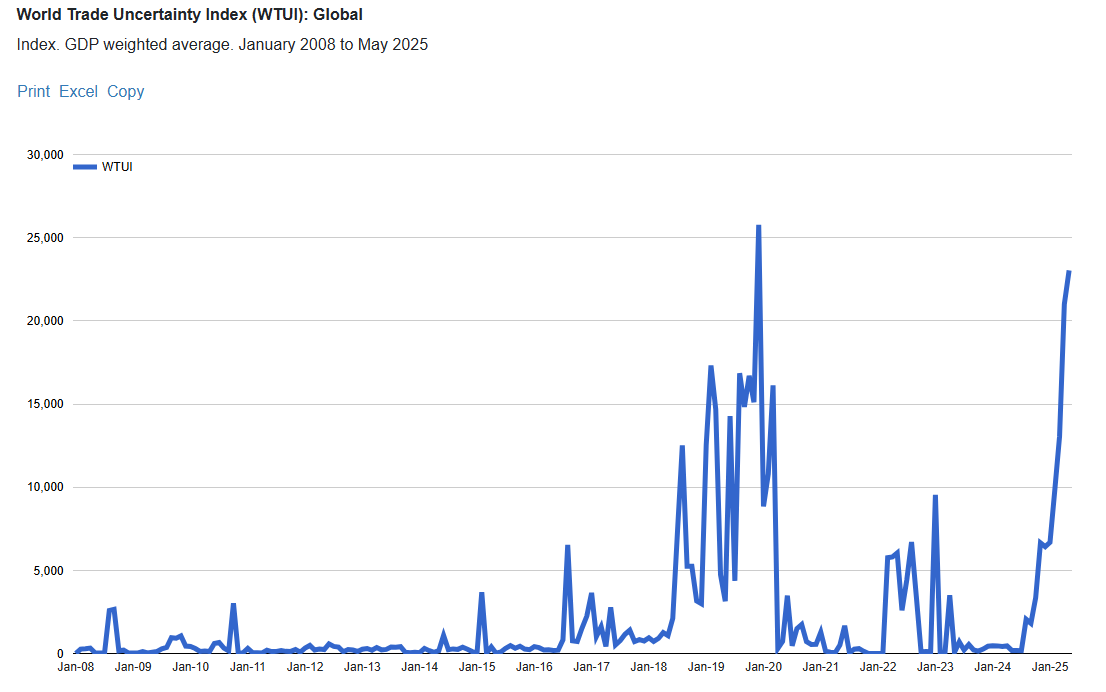Here's the rundown on the WTUI
The World Trade Uncertainty Index (WTUI) measures uncertainty in global trade policy based on economic data and text analysis of major reports. From 2008 to 2017, the index was largely stable, reflecting a relatively predictable global trade environment. But since 2018, the WTUI has surged with spikes around events like Brexit, U.S.-China trade tensions, COVID-19, the Ukraine war, and now, renewed geopolitical and economic pressures. For business leaders, WTUI signals when to reassess risk exposure, supply chain resilience, and strategic positioning.
What Is the World Trade Uncertainty Index (WTUI)?
The WTUI is an economic indicator developed by economists at the International Monetary Fund (IMF) to track trade-related uncertainty across the globe. It uses advanced text mining from country reports, news, and policy documents to calculate an index that reflects global anxiety around trade policies and practices.
The higher the WTUI, the more uncertainty businesses and markets are facing when it comes to international trade.
It is GDP-weighted, meaning larger economies influence the score more heavily. The WTUI is a powerful signal of the global mood when it comes to trade, investment, and policy confidence.
What Drives the WTUI?
Several major factors influence WTUI spikes:
- Geopolitical conflicts (e.g., Russia-Ukraine war, Middle East tensions)
- Trade policy shifts (e.g., U.S.-China tariffs, Brexit)
- Pandemics and global health events (e.g., COVID-19)
- Supply chain disruptions (e.g., semiconductor shortages, Suez Canal blockage)
- Economic volatility (e.g., inflation, interest rate shocks)
These events disrupt predictability in trade, cause delays or renegotiation of deals, and prompt businesses to rethink sourcing, pricing, and logistics.
How the WTUI Has Changed Since 2008
Looking at the graph, we clearly see that from 2008 to late 2017, the index remained remarkably stable, generally below 5,000. This period of calm matched a time of steady globalization, trade liberalization, and economic recovery after the Global Financial Crisis.
But starting in 2018, we enter a new era:
- 2018–2019: U.S.-China trade war → major spike
- 2020: Global COVID-19 pandemic → highest-ever peak (~27,000)
- 2022–2023: Ukraine war, inflation, rate hikes → volatility
- 2024–2025: Rising geopolitical tensions, elections, and supply fragility → sharp rise again
As of May 2025, the WTUI is again approaching record highs suggesting that we are once again entering a period of heightened uncertainty for global trade.
Why the WTUI Matters for Businesses
If you're a business leader, executive, or supply chain planner, WTUI isn’t just an academic number it's a warning light on the dashboard of global commerce.
Here's what it means in practical terms:
📉
Forecasting becomes harder
Market signals get murky. Budgeting and inventory decisions carry higher risk.
🚛
Supply chains are under pressure
Longer lead times, higher costs, and more demand for local/alternative sourcing.
📈
Costs go up and margins tighten
Uncertainty breeds inefficiency. Delays and price volatility eat into profits.
🌍
Diversification is no longer optional
One region or one supplier? That’s a gamble in today’s climate.
🧠
Strategy must be agile, not rigid
Long-term planning must include contingency and scenario models.
What Should Businesses Do Now?
To navigate an era of rising trade uncertainty:
✅ Monitor global indicators like the WTUI regularly
Don't be blindsided. Build it into your economic outlook and risk models.
✅ Reassess supply chain risk
Map out tier-1 and tier-2 supplier risks. Consider local, regional, and digital alternatives.
✅ Invest in resilience
Business continuity plans, backup suppliers, flexible contracts are no longer luxuries.
✅ Stay informed
Partner with advisors who track geopolitical, economic, and trade trends. Speed of response matters.
Final Thoughts
Here’s the rundown on the WTUI and why World Trade Uncertainty: What It Means for Your Business matters more than ever. The World Trade Uncertainty Index (WTUI) isn’t just a trending metric it’s a leading indicator of disruption. With trade volatility potentially eroding GDP, impacting supply chains, and shifting investment landscapes, businesses must stay informed to stay resilient. Understanding the WTUI provides clarity on how global trade sentiment is evolving and what that means for your operations, pricing, and strategy. When uncertainty is high, alignment, flexibility, and readiness become your competitive edge.
At Josty, we help businesses across New Zealand and beyond make sense of economic signals like WTUI, turning complexity into clarity and uncertainty into opportunity.
If your business is relying on global supply chains, cross-border transactions, or simply wants to stay competitive in uncertain times now’s the moment to get proactive.
📊
Need help understanding what
trade risk means for your business?
👉
Let’s talk about trade strategy, continuity planning, and future-proofing your business.
Post written by Jason Jost

